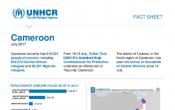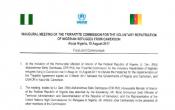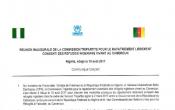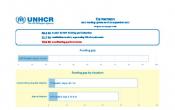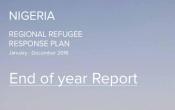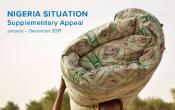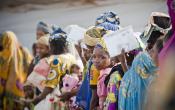Cameroon
Operation: Cameroon
Location
{"longitude":12,"latitude":5,"zoom_level":0}
Latest update of camps and office locations 21 Nov 2016. By clicking on the icons on the map, additional information is displayed.
Key Figures
| 2016 end-year results | |
| 100% | of people of concern were registered on an individual basis |
| 72% | of Central African refugee women have been supplied with sanitary material |
| 56% | of Central African refugee children enrolled in primary school |
| 15% | of internally displaced households lived in adequate dwellings |
| 315 | reported incidents for which survivors receive material assistance |
| 2017 planning figures | |
| 100% | of people of concern will be registered on an individual basis |
| 100% | of people of concern who report sexual and gender-based violence (SGBV) incidents will receive appropriate support |
| 260,000 | people of concern will receive shelter support |
| 80,400 | people of concern will receive input for livelihoods activities |
| 68,900 | registered refugee children will be enrolled in primary education |
Latest Updates and Related Links
January - December 2017
People of Concern
30%
Increase in
2016
2016
| 2016 | 595,935 |
| 2015 | 459,650 |
| 2014 | 276,265 |

[["Refugees",348672],["Refugee-like situation",26743],["Asylum-seekers",3251],["IDPs",198889],["Returned IDPs",18213],["Returned refugees",134],["Others of concern",33]]
Loading ...
Cameroon
< Back
2016
{"categories":[2012,2013,2014,2015,2016,2017],"budget":[20.6565492,23.58358842,81.27658602,114.697643602,98.624602509,94.24482876],"expenditure":[10.76662458,12.96600018,44.17872352,50.71501571,50.50994132,null]}
{"categories":[2012,2013,2014,2015,2016,2017],"p1":[19.83024575,22.80065742,80.48365484,107.653576378,89.476459699,87.79606214],"p2":[0.82630345,0.782931,0.79293118,0.843987224,1.885381,1.14850401],"p3":[null,null,null,null,null,null],"p4":[null,null,null,6.20008,7.26276181,5.30026261]}
{"categories":[2012,2013,2014,2015,2016,2017],"p1":[10.54988338,12.84369964,44.04089519,45.95148629,46.39734147,null],"p2":[0.2167412,0.12230054,0.13782833,0.207295,1.36677006,null],"p3":[null,null,null,null,null,null],"p4":[null,null,null,4.55623442,2.74582979,null]}
Loading ...
CHOOSE A YEAR
- 2014
- 2015
- 2016
- 2017
Working environment
In 2016, Cameroon continued to face insecurity in the Far North region. Violent attacks by Boko Haram and counter-insurgency measures have led to the internal displacement of almost 192,910 people registered in the Far North region. At the end of 2016, more than 200,000 Nigerians sought refuge in neighbouring countries, including some 86,000 Nigerian refugees in Cameroon, of whom 60,000 are accommodated in Minawao camp.Insecurity and fear of terrorism impeded humanitarian access and made it challenging for UNHCR to maintain asylum space. Hundreds of cases of forced returns to Nigeria were reported during the year.
In addition, some 259,100 CAR refugees remain in rural areas in the East, the North and Adamaoua with 30 per cent living in seven organised sites and 70 per cent accommodated by host communities. The pace of influx of CAR refugees reduced during 2016. Some 23,600 refugees and asylum seekers reside in urban areas (mainly in Douala and Yaoundé),
The sudden arrival of a high number of refugees fleeing the conflict in the CAR and Nigeria to areas where access to basic infrastructure was already limited before their arrival, has placed a strain on scarce resources and has, in some areas, increased the perception of insecurity among the local population.
UNHCR continued to coordinate the refugee response within the country, while contributing to different regional response mechanisms, including the Humanitarian Response Plan (HRP) and the Regional Refugee Response Plan (RRRP) for Nigerian refugees. UNHCR mobilized all agencies of the UN Country Team. The refugee coordination model was equally used to coordinate assistance to IDPs.
Population trends
- In 2016, UNHCR and Cameroonian authorities registered the arrival of 6,000 new refugees from the Central African Republic, which is less than in 2015 (21,000) and 15,000 new Nigerian refugees.
- At the end of 2016, 378,700 refugees and asylum seekers were registered in Cameroon, comprising 53 per cent female and 47 per cent male. Children made up 56 per cent of the total refugee population and 4 per cent of refugee were over 60 years old.
- 6 per cent of refugees lived in urban areas (mainly Douala and Yaoundé). 71 per cent originated from the Central African Republic and were settled in the regions of the North, the East and Adamaoua, and 23 per cent of Nigerian refugees lived in the Far North region.
Achievements and impact
- UNHCR engaged with development actors, including the World Bank to prepare the next International Development Association (IDA) covering the period of 2017-2019 to support refugee-hosting countries.
- Several studies were undertaken to implement the solutions strategy focusing on access to national services and self-reliance for refugees. Agreements with line ministries (Ministère de l’économie, de la planification et de l’Aménagement du Territoire, Ministère des affaires sociales, Ministère de la sante) were signed in this regard.
- Individual registration covered the entire refugee population within the country, disaggregated data exists for all refugees. Biometric registration of all refugees, expected to be completed in 2017, will improve data quality and help to harmonize refugee documentation.
- 4,860 refugee children were registered with national civil authorities and received birth certificates. 55,326 refugee children were enrolled in primary school.
Unmet needs
- High malnutrition and mortality rates for children under five years and anaemia remain a serious concern, especially among the Central African refugees. In the second half of 2016, food rations provided by WFP were significantly cut, forced by funding shortfalls.
- Despite the notable progress made to increase the access of refugee children to secondary education, enrolment rate remained low. Out of 30,205 secondary school-aged refugee children, only 10 per cent were enrolled in secondary school.
- Due to funding shortfall, inadequate basic domestic items were provided to Nigerian and urban refugees. Only 21 per cent of urban refugee households, 24 per cent of Nigerian refugee households and 11 per cent of internally displaced households received core-relief items.
Cameroon has long been a pillar of stability in a troubled region, and hence a destination for people fleeing conflict in search of asylum. The country, which has signed the 1951 Refugee Convention and the 1969 OAU Refugee Convention, has translated its commitments into action and maintained an open-border policy for asylum-seekers, providing land, access to social infrastructure and security.
Cameroon hosts the largest number of refugees from the Central African Republic (CAR), with more than 250,000 refugees in need of assistance as of June 2015. Over 150,000 refugees from the CAR arrived following inter-communal violence in 2013-2014; the others have been hosted in Cameroun since 2003. The majority of refugees have settled in host communities and depend mainly on local health, WASH and education services, while about 62,000 are settled in seven refugee sites where multi-sectoral assistance is being provided. In addition, Cameroon has witnessed a significant influx of more than 57,000 Nigerian refugees in the Far North following escalating violence in Nigeria’s Adamawa, Borno and Yobe states, and the internal displacement of 81,000 people due to cross-border incursions of armed groups.
The sudden arrival of a high number of refugees fleeing the conflict in the CAR and Nigeria to areas where access to basic infrastructure was already limited before their arrival, has placed a strain on scarce resources and has, in some areas, increased the perception of insecurity among the local population.
In order to avoid potential intercommunal conflicts and strengthen social cohesion between host populations and refugees, assistance and investments in social infrastructure need to be extended in 2016 to cater for refugees living outside designated sites, and also to include the communities hosting them. Insecurity in border areas and refugee-hosting areas will remain a challenge and will have an impact on the readiness of the Government to allow refugees to reside outside of secured refugee sites in the eastern parts of the country. Due to increased insecurity, including violent attacks against civilians in the Far North, which make humanitarian access to certain areas very challenging, the Government is promoting an encampment policy in this situation to ensure effective protection and assistance for Nigerian refugees. In view of continuing new arrivals, UNHCR is advocating for the opening of a second camp for Nigerian refugees. The population of Minawao camp, which was initially built to accommodate a maximum of 15,000 refugees, has grown from 6,000 in 2013 to more than 45,000 in August 2015. The decongestion of the existing camp is critical in order to provide assistance in accordance with minimum standards, especially with regard to access to drinking water which remains a major challenge.
In areas hosting refugees from the CAR, UNHCR aims to step up its support to the Cameroonian authorities to assist out-of-site refugees and enhance the basic social infrastructure in refugee-hosting areas in collaboration with development actors. Livelihood activities should stimulate the local economy, facilitating the economic integration of refugees and reducing pressure on natural resources. Lack of investment in the health, education, WASH and livelihoods sectors in support of both the host and refugee populations will increase the risk of social tensions.

